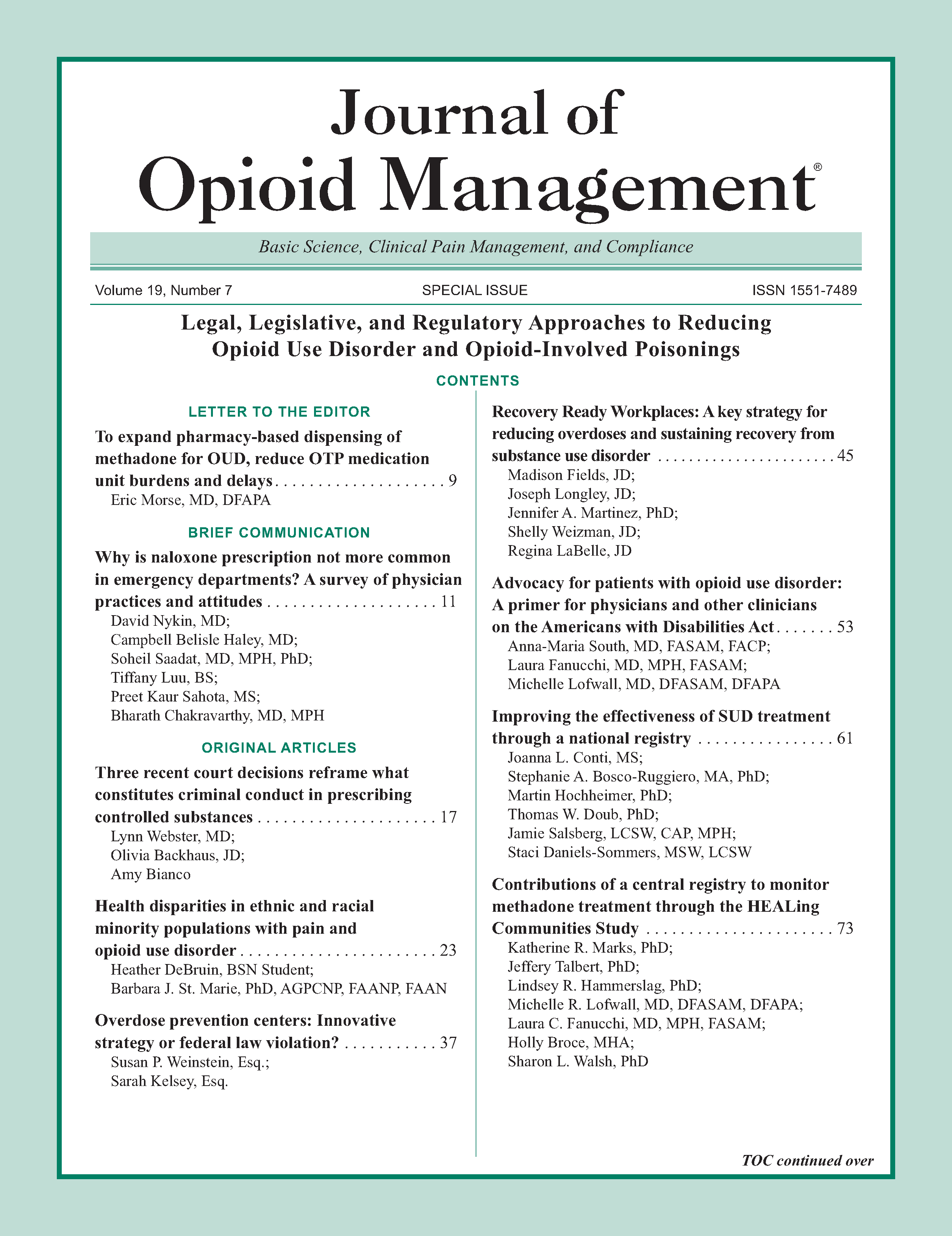Why is naloxone prescription not more common in emergency departments? A survey of physician practices and attitudes
DOI:
https://doi.org/10.5055/jom.2023.0794Keywords:
naloxone, opioid, emergency physician, emergency department, prescriptionsAbstract
Objective: Emergency physicians (EPs) have a singular opportunity to prescribe naloxone and decrease fatal overdoses in opioid users. We surveyed EPs patterns of naloxone prescription and identified barriers to prescribing naloxone.
Design: Surveys were conducted at an emergency medicine conference from 2018 to 2019. We used a Likert scale for all questions and a chi-square or chi-square for trend tests to determine statistical significance.
Setting: Emergency medicine conferences and emergency departments.
Participants: Forty-one EPs were surveyed.
Intervention: Oral survey.
Main outcome measures: Prevalence of naloxone prescription and EP attitude toward naloxone.
Results: 65.0 percent of residents and 33.3 percent of attending physicians had never prescribed naloxone to patients. 90.2 percent believed ED naloxone prescription is safe, 82.9 percent did not refrain from prescribing due to ethical concerns, and 73.2 percent believed it is not a waste of resources.
Conclusions: Many resident physicians had never prescribed naloxone despite agreeing it was safe, ethical, and a productive use of resources. The time needed to counsel patients on naloxone use was a barrier to prescription, and various interventions are needed to make this practice more common.
References
Vital Signs: Drug overdose deaths, by selected sociodemographic and social determinants of health characteristics—25 states and the District of Columbia. 2019-2020. Available at https://www.cdc.gov/mmwr/volumes/71/wr/mm7129e2.htm?s_cid=mm7129e2_w. Accessed July 22, 2022. DOI: https://doi.org/10.15585/mmwr.mm7129e2
National Institute on Drug Abuse: Opioid overdose crisis. 2021. Available at https://www.drugabuse.gov/drug-topics/opioids/opioid-overdose-crisis. Accessed May 26, 2021.
Smart R, Pardo B, Davis CS: Systematic review of the emerging literature on the effectiveness of naloxone access laws in the United States. Addiction. 2021; 116(1): 6-17. DOI: 10.1111/add.15163. DOI: https://doi.org/10.1111/add.15163
Rees DI, Sabia JJ, Argys LM, et al.: With a little help from my friends: The effects of good Samaritan and naloxone access laws on opioid-related deaths. J Law Econ. 2019; 62(1): 1-27. DOI: https://doi.org/10.1086/700703
Food and Drug Administration: FDA approves first over-the-counter naloxone nasal spray. US Food and Drug Administration. 2023. Available at https://www.fda.gov/newsevents/press-announcements/fda-approves-first-over-counternaloxone-nasal-spray. Accessed June 2, 2023.
Briesacher BA, Gurwitz JH, Soumerai SB: Patients at-risk for cost-related medication nonadherence: A review of the literature. J Gen Intern Med. 2007; 22: 864-871. DOI: 10.1007/s11606-007-0180-x. DOI: https://doi.org/10.1007/s11606-007-0180-x
Fareed A, Eilender P, Ketchen B, et al.: Factors affecting noncompliance with buprenorphine maintenance treatment. J Addict Med. 2014; 8(5): 345-350. DOI: 10.1097/ADM.0000000000000057. DOI: https://doi.org/10.1097/ADM.0000000000000057
Chua KP, Dahlem CHY, Nguyen TD, et al.: Naloxone and buprenorphine prescribing following US emergency department visits for suspected opioid overdose: August 2019 to April 2021. Ann Emerg Med. 2022; 79(3): 225-236. DOI: 10.1016/j.annemergmed.2021.10.005. DOI: https://doi.org/10.1016/j.annemergmed.2021.10.005
Penm J, MacKinnon NJ, Lyons MS, et al.: Combatting opioid overdoses in Ohio: Emergency department physicians' prescribing patterns and perceptions of naloxone. J Gen Int Med. 2018; 33: 608-609. DOI: 10.1007/s11606-018-4353-6. DOI: https://doi.org/10.1007/s11606-018-4353-6
McClellan C, Lambdin BH, Ali MM, et al.: Opioid-overdose laws association with opioid use and overdose mortality. Addict Behav. 2018; 86: 90-95. DOI: 10.1016/j.addbeh.2018.03.014. DOI: https://doi.org/10.1016/j.addbeh.2018.03.014
Kilaru AS, Liu M, Gupta R, et al.: Naloxone prescriptions following emergency department encounters for opioid use disorder, overdose, or withdrawal. Am J Emerg Med. 2021; 47: 154-157. DOI: 10.1016/j.ajem.2021.03.056. DOI: https://doi.org/10.1016/j.ajem.2021.03.056
Drainoni M-L, Koppelman EA, Feldman JA, et al.: Why is it so hard to implement change? A qualitative examination of barriers and facilitators to distribution of naloxone for overdose prevention in a safety net environment. BMC Res Notes. 2016; 9. DOI: 10.1186/s13104-016-2268-z. DOI: https://doi.org/10.1186/s13104-016-2268-z
Coffin PO, Sullivan SD: Cost-effectiveness of distributing naloxone to heroin users for lay overdose reversal. Ann Internal Med. 2013; 158(1): 1-9. DOI: https://doi.org/10.7326/0003-4819-158-1-201301010-00003
American College of Emergency Physicians: Naloxone access and utilization for suspected opioid overdoses. 2016. Available at https://www.acep.org/globalassets/new-pdfs/policystatements/naloxone-access-and-utilization-for-suspected-opioid-overdoses.pdf. Accessed May 26, 2021.
The Pew Charitable Trusts: Expanded access to naloxone can curb opioid overdose deaths. 2020. Available at https://www.pewtrusts.org/en/research-and-analysis/issue-briefs/2020/10/expanded-access-to-naloxone-can-curb-opioid-overdosedeaths. Accessed May 26, 2021.
Gonzalez AM, Arlandson ME, Patel A, et al.: Predictive factors associated with naloxone prescription among pregnant people admitted for the management of opioid use disorder. Am J Perinatol. 2022. DOI: 10.1055/a-1975-4534. DOI: https://doi.org/10.1055/a-1975-4534
Holland TJ, Penm J, Dinh M, et al.: Emergency department physicians' and pharmacists' perspectives on take-home naloxone. Drug Alcohol Rev. 2019; 38(2): 169-176. DOI: 10.1111/dar.12894. DOI: https://doi.org/10.1111/dar.12894
American Psychological Association: Substance use during the pandemic. 2021. Available at https://www.apa.org/monitor/2021/03/substance-use-pandemic. Accessed May 6, 2021.
Published
How to Cite
Issue
Section
License
Copyright 2005-2025, Weston Medical Publishing, LLC and Journal of Opioid Management. All Rights Reserved.











